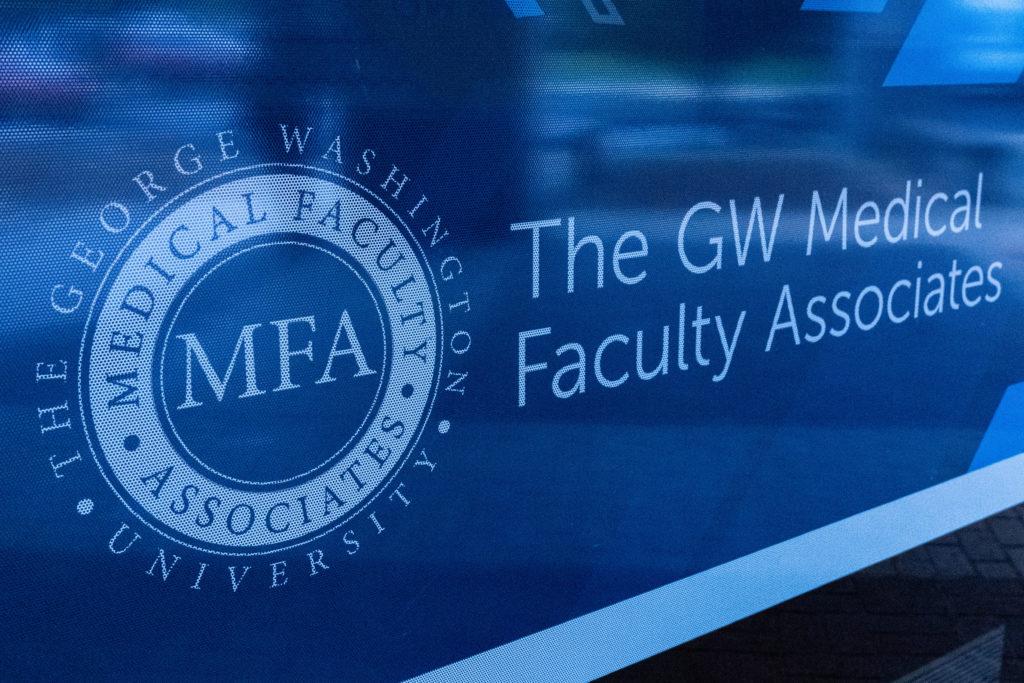The Medical Faculty Associates’ malpractice compensation costs – expenses for legal payouts and insurance premiums and reserves – have surged over the last three years despite a drop in legal claims and payouts, reflecting a national trend of growing malpractice insurance costs.
The MFA – a group of physicians and faculty from the School of Medicine and Health Sciences and physicians at the GW Hospital – spent $14.6 million on malpractice compensation in 2022, a 114 percent jump over the past three years, according to data that officials presented to faculty senators earlier this month. MFA malpractice compensation increased by more than $7 million from 2019, including a $600,000 increase from last year – a trend that officials partly attribute to rising insurance costs, despite dwindling malpractice lawsuit filings against the MFA in the same period.
Payouts and filed claims for malpractice lawsuits haven’t demonstrated growth similar to that of the MFA’s malpractice compensation, according to D.C. Superior Court records and data from the National Practitioner Data Bank. The number of malpractice lawsuits filed against the MFA and the amount of malpractice payment reports in medical facilities across D.C. and the country have decreased since 2019, the records and data show.
Plaintiffs filed 19 malpractice lawsuits against the MFA in 2020, a jump up from 12 cases in 2019, but the number of filings dropped to nine in 2021 and four so far this year, according to court records.
One of the 12 lawsuits filed against the MFA in 2019 and one of the 19 cases filed in 2020 reached settlements, but all closed cases filed since 2021 were dismissed, court records show. As of Monday, one of the 12 lawsuits filed in 2019 remains open, compared to nine open cases from 2020, three from 2021 and all four cases filed this year, according to the records.
Court records do not reveal how much the settlements were worth or share further details about the settlements.
The total number of malpractice payment reports filed by practitioners in D.C. fell from 23 in 2021 to nine so far this year – which includes reports from up to June 30, according to the NPDB, which collects data from health care providers and entities across the country. The data shows national numbers for the number of payouts dropped by about a quarter since 2019.
The MFA, a University-operated nonprofit, lost nearly $80 million by the end of the fiscal year in June, and the rise in malpractice compensation costs accounted for an extra $7.8 million in expenses for the nonprofit that was not a factor in 2019.
University spokesperson Josh Grossman said the MFA’s malpractice expenses include several years of “historical claims,” and include insurance premiums and “reserve true ups” – money set aside by insurance companies for lawsuits not yet filed or settled – from previous years. He said overall insurance costs jumped during the pandemic, but the MFA’s premiums and reserve costs have not increased substantially over the last year – in line with the MFA’s overall malpractice compensation costs over the last year.
“In general, the cost of insurance has increased over the past few years across most lines since the pandemic,” Grossman said in an email. “MFA experienced very little increase in premiums and reserve requirements over the last year.”
Grossman said the medical malpractice insurance market has “high confidence” in the MFA. He declined to specifically say why the MFA’s malpractice compensation has increased since 2019 or how it relates to the number of lawsuit payouts or claims.
GW entered an agreement with the MFA in 2007 to have the MFA’s medical professional liability insurance policy cover the University’s employed physicians, residents and interns. The policy was written by the MFA Physicians Insurance Company, a subsidiary of the MFA which was previously based in the Cayman Islands but transferred to D.C. during the last fiscal year.
The company offers coverage on a claims-made basis with limits of $3 million per occurrence and $12 million annually per individual employee.
The American Medical Association published a report in March stating the cost of medical liability insurance has increased nationally over the last three years by a proportion not seen for more than a decade, with nearly 30 percent of industry premiums increasing between 2020 and 2021.
The March report states the pandemic hasn’t driven up base premium costs, and the pandemic’s long-term effects on malpractice insurance costs are “still unknown.”
Medical liability insurance data from the National Association of Insurance Commissioners states medical liability insurers in D.C. reported an average loss rate of 63 percent in 2021 because of claim payments that calendar year. Though the District’s loss rate fell under the national average of about 69 percent in 2021, the rate wasn’t that high in D.C. since 2007 with the exception of 2019 when it reached 88 percent.
Experts said rising premiums may be the biggest factor accounting for the MFA’s increasing malpractice compensation costs, because nationwide, regional and MFA-specific malpractice claims have decreased during the same period.
Dan Singer, a partner at Trombly & Singer law firm, said he is “skeptical” that the rise in MFA compensation costs can be attributed to a rise in actual claim payouts because of the national decrease in reports. He said rising premiums are a possible explanation for the increase because liability insurance companies have inflated malpractice coverage costs under the guise of a concrete increase in claim payouts in the past.
Singer said a 2020 study shows medical malpractice insurers overrepresented actual losses from 2002 to 2005 by 33 percent and used those inflated figures to charge doctors higher premiums for malpractice insurance. Singer said there isn’t evidence of rising payout costs today, and the insurance companies may be using inflated losses to charge insured doctors more.
“There is no real evidence of rising claim payouts,” Singer said in an email. “Consumer advocates who study this issue have concluded that this rhetoric is often used to price gouge insurance customers.”
Mark Hall, a professor of public health at Wake Forest University, said liability insurance costs can rise for broader financial market reasons “entirely unrelated” to actual suits or payouts because insurers rely significantly on financial investments with the funds they collect.
Hall said if the MFA started providing coverage for more healthcare providers in recent years or increased the number of physicians it employs, compensation coverage costs would rise regardless of premium rates or the amount of claims filed. The MFA currently employs roughly 700 SMHS physicians and other advanced practice providers, according to documents obtained under the Freedom of Information Act in September.
“If that’s the cause, then there isn’t necessarily an increase in the aggregate, only a shift in who is paying the claims,” Hall said in an email.
Stephen Landsman, an emeritus law and social policy professor at DePaul University, said the sum paid out to policyholders for individual malpractice claims has “certainly” increased in recent years, but not necessarily the total claims reported. He said the increase in payout quantities is a symptom of current economic inflation affecting the medical industry because the price an insurance company may have to pay a policyholder to compensate for malpractice will increase as overall prices for medical care grow.
“With medical care, the rate of inflation usually exceeds what’s going on in the rest of the economy,” Landsman said. “You have a spiral upwards.”
Peyton Gallant contributed reporting.








